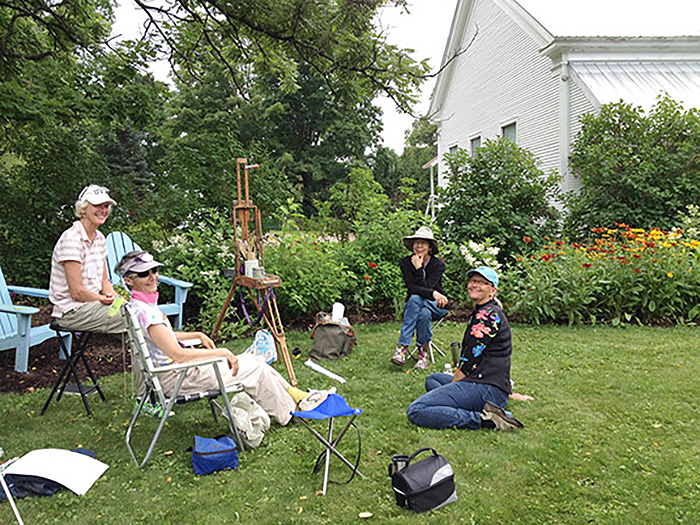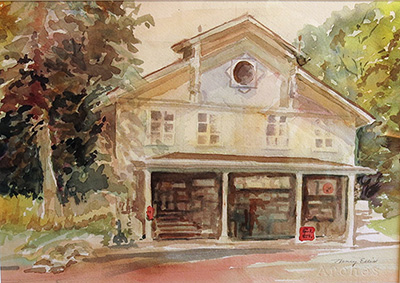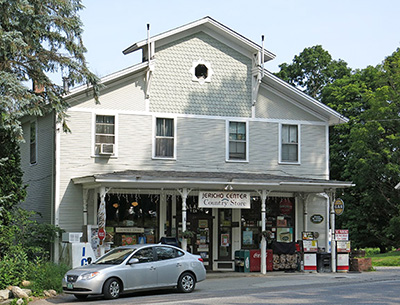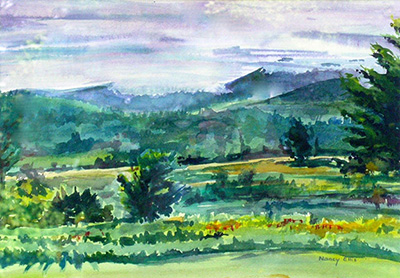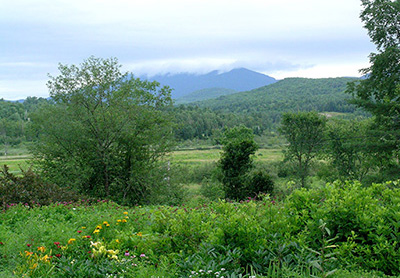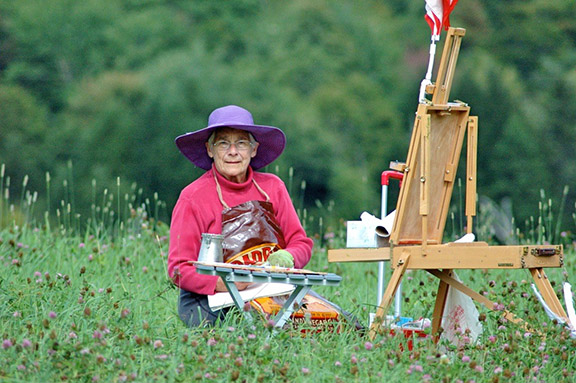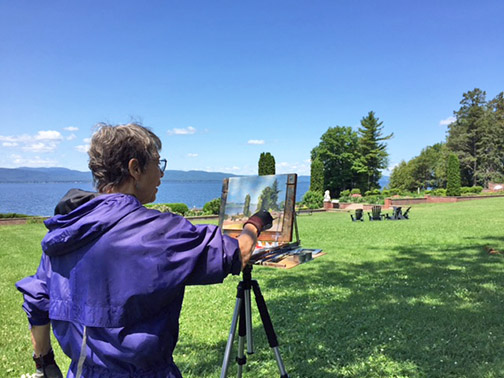| Painting in Vermont’s Plein Air | |||||
| by Cynthia Close | |||||
| Vermont’s mountains, lakes, and picturesque farmland have lured artists since the early 19th century. In 2013, the Middlebury College Museum of Art presented an exhibition of little-known Vermont landscape paintings by Edward Hopper, the famed painter of New York urban life. The show included references to similar work by his wife, Jo (Josephine Verstille Nivison), who was also an artist. The documentation accompanying the exhibition described how they would drive around the back roads of Vermont during their summer vacations between 1927 and 1938 looking for scenes to paint. When they found a spot that interested them, they would park their roadster, and Hopper would usually paint the view from the backseat where he had more legroom to stretch out his six-foot-five frame, while his wife sat and painted in the front. | |||||
Four plein air peintres during a lunch break at the fifth Plein Air Festival.
|
|||||
The French term plein air literally means “open air” or the outdoors and has evolved to suggest painting directly from nature. Historically, we can trace plein air to French artists Nicolas Poussin and Jean-Baptiste-Camille Corot, who painted in Rome in the 17th and 18th centuries. Today, it is the continued popularity of impressionists like Claude Monet and Pierre-August Renoir, who came on the scene in the late 19th century, along with their female counterparts Berthe Morisot and Mary Cassatt, who we most associate with the atmosphere and fresh, bold color achieved by painting in natural light.
While the Hoppers utilized the comfort that twentieth-century technology offers to those artists who want to avoid the inconveniences of working out of doors, others embrace all that nature has to offer: mosquitos, sweltering sun, wind, and the occasional unavoidable raindrops. Some don’t even wait for the warmer months of what is typically plein air season here in Vermont; they paint year-round. Erik Tobin is an example of a brave artist who is not intimidated by Vermont winters. A well-known, self-taught regional landscape painter, he produces beautiful snow-covered landscapes painted outdoors in harsh weather. However inspiring a violet-colored shadow across an icy expanse may be, most Vermont artists wait until after mud season to emerge, looking for opportunities to work outside. There are many, as painting in plein air has become a huge, worldwide movement, with an explosion of interest in the last 10 to 20 years. Practitioners even have a magazine titled Plein Air.
|
|||||
|
|||||
|
The many festivals where artists can participate have become both expensive and highly competitive. “Name” artists are often invited to take part, while many others, who are in it for the love of nature as well as the camaraderie of their peers, get shut out. In 2010, three Vermont artists and longtime friends—Barbara Greene, Jane Morgan, and Emilie Alexander—decided to create an event that would bring artists together in an egalitarian way while also providing more visibility for their work. They conceived of a one-day outdoor painting festival, followed immediately by an exhibition of all the work created on that day.
Alexander is the owner of Emile A. Gruppe Gallery, in Jericho, Vermont, named after her father who was a respected landscape painter. She enthusiastically offered the gallery space to house the exhibition and to be the geographic hub for the festival. The gallery is the result of a 2003 renovation of the sheep barn, which is also home to the Jericho Settlers Farm CSA (community supported agriculture) program. It was built primarily to display and sell Emile Gruppe’s paintings, a legacy the artist left to his daughter. The space is well conceived, blending the rustic qualities of Vermont post-and-beam architecture with contemporary white walls, which have accommodated the works of many artists, from New England and beyond.
These three friends wanted to make their festival a noncompetitive welcoming place where local artists could gather, share tips, make friends, and enjoy the natural beauty of the surrounding countryside. They sent out an e-mail announcing their plans for the first free event to about 35 artists and friends. The response was overwhelming. Word spread and over 100 artists responded, chaos resulting. In spite of that, it was evident there was tremendous interest; they just had to adjust their perspective, set limits on participation, and perhaps charge a minimal fee to sign up. The festival continues to be been held annually, rain or shine, and every year sees a large number of returning skilled professionals as well as young artists looking to learn and refine their craft. This year, registration requires a modest fee of $20 payable to Jericho Plein Air Festival. Registration was to remain open until May 15, 2016, or until they reached capacity, which this year was capped at 65 participants. The festival quickly reached its quota by mid-March and currently has a waiting list. Besides access to charming vistas to paint in and around Jericho (local residents and landowners have been most welcoming), the festival offers breakfast bright and early starting at 7 a.m. They also hand out maps of the area to the participants, denoting painting sites. Some artists have attended the festival every year and have gotten together in informal painting groups of three or four friends, painting outdoors in other parts of Vermont throughout the season. Since the stated goal of the festival is “celebrating, nurturing and enhancing the visibility of our Art Community,” the general public is also invited to wander around the festival sites on Saturday. Plein air painting has become something of a spectator sport, drawing on people's desire to watch the process of creating art. Some artists enjoy interacting with the public, others, not so much, but the festival organizers point out it is “a terrific opportunity to help people understand the different approaches and processes artists use as they create, and to deepen public understanding of both art and artists.” Some artists, like Burlington painter Nancy Ellis, have even sold work right off their easel before the paint was dry.
Jane Neroni, an accomplished painter and former instructor at RISD (Rhode Island School of Design), currently teaches botanical illustration at UVM and is an enthusiastic participant in the Jericho Plein Air Festival. She willingly shares her knowledge of the best equipment —portable easel, lightweight collapsible stool, sun umbrella, and so on—that can make the plein air painters’ life more efficient. Neroni is also a contributor to the Bryan Gallery in Jeffersonville, where she shows her work. The Bryan Gallery (www.bryangallery.org) is a membership organization promoting a large number of artists specializing in landscape, many of whom travel about the state painting outdoors. Part of the excitement of participating in the Jericho festival is the option of exhibiting the work created that Saturday in the Gruppe Gallery. A large tent is provided on the grounds near the gallery where the artists can frame the work they produced during the day. Often artists most experienced in cutting mats and assembling frames willingly assist those who are more challenged in that skill set. After framing, the work is left for the organizers to hang, finishing in time for the opening reception the next day. This year the reception will be held on Sunday, July 17, from 2 to 4 p.m. The exhibition provides an opportunity for the artists to share their work with family, friends, and the public. Most of the works are for sale, and the exhibit will remain in the gallery until Sunday, August 7. The Jericho Plein Air Festival is now one of the most successful events held annually in the summer in Vermont, but it is not the only place where artists can practice their craft. The Great Plein Air Paint-Out, held in Waitsfield in August, is part of the Vermont Festival of the Arts. It, too, has become a popular two-day event, boosting the local economy by drawing folks from out of town who frequent Waitsfield’s restaurants and hotels. This year, in January, the festival celebrated the grand reopening of its renovated and expanded gallery. The Festival Gallery, on Main Street in Waitsfield, hosts a number of exhibitions throughout the year. Most of us, as children, made art in a very uninhibited way. As we got older, criticism and self-consciousness often inhibited our expression as creators, and we began avoiding both the making of art and appreciating the work of others. In true Vermont fashion, these plein air events are all about creating community in an unpressured, laid-back, and enjoyable way. They also provide a path back to nature, through a new understanding of making art.
|
|||||
Photos: courtesy of the artists. |
Cynthia Close is a contributing editor for Documentary Magazine, art editor for the literary journal Mud Season Review, and an adviser to the Vermont International Film Festival. She lives in Burlington, Vermont, with her doggie, Ethel.
|
||||
